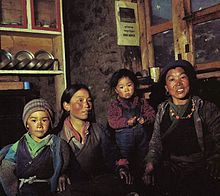Sherpa people

Sherpa family with traditional Sherpa clothing
|
|
| Total population | |
|---|---|
| 152,000 estimate | |
| Regions with significant populations | |
| Nepal, China (Tibet), Bhutan, India (Sikkim, Arunachal Pradesh, Darjeeling) | |
| Languages | |
| Sherpa, Nepali | |
| Religion | |
| Predominantly Tibetan Buddhism (93%) and minority: Hinduism, Bön, Christianity | |
| Related ethnic groups | |
| Tibetans, Jirels |
Sherpa (Tibetan: "eastern people", from shar "east" and pa "people") are an ethnic group from the most mountainous region of Nepal, the Himalayas.
Sherpa as a surname is the result of mistaken census takers of the Nepalese government. Not recognizing that some people only have one name, census takers wrote "Sherpa" in the place of a last name. The surname "Sherpa" has thus been adopted and involuntarily used as last names even though last names are not part of Sherpa culture.
Most Sherpa people live in Nepal's eastern regions; however, some live farther west in the Rolwaling valley and in the Helambu region north of Kathmandu. Tengboche is the oldest Sherpa village in Nepal. Sherpa people also live in Tibet, Bhutan, as well as in the Indian states of Sikkim and the northern portion of West Bengal, specifically the district of Darjeeling. The Sherpa language belongs to the south branch of the Tibeto-Burman languages, and it is mixed Eastern Tibet (Khamba) and Lhasa dialogue. However, this language is separate from Lhasa Tibetan and unintelligible to Lhasa speakers.
The number of Sherpas migrating to the West has significantly increased in recent years, especially to the United States. New York City has the largest Sherpa community in the United States, with a population of approximately 2,500. The 2001 Nepal census recorded 154,622 Sherpas within its borders. Some members of the Sherpa population are known for their skills in mountaineering.
The Sherpa were nomadic people who first settled in the Solukhumbu District (Khumbu), Nepal, then gradually moved westward along salt trade routes. According to Sherpa oral history, four groups migrated out of Solukhumbu at different times, giving rise to the four fundamental Sherpa clans: Minyagpa, Thimmi, Sertawa and Chawa. These four groups have since split into the more than 20 different clans that exist today. About 1840, Sherpa ancestors migrated from Kham. Mahayana Buddhism religious conflict may have contributed to the migration in the 15th and 16th centuries. Sherpa migrants traveled through Ü and Tsang, before crossing the Himalaya.
...
Wikipedia
